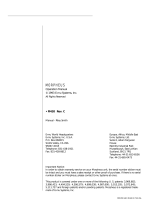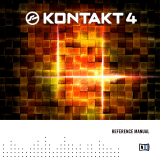Page is loading ...

© Copyright Precisionsound 2012 www.precisionsound.net
Angelic Vocal Pads 5
for NI Kontakt, HALion, EXS24 & SoundFont
Angelic Vocal Pads 5 is a collection of beautiful and silky pad instruments for music production and
sound design. Unlike most choir libraries, the Angelic Vocal Pads series of sample libraries layers
multiple voices from a single singer in each vowel. The sound of the Angelic Vocal Pads has a
personality within each installment that makes it unique, due to the singer who performs in that
particular library. Angelic Vocal Pads 5 features the voice of Swedish folk/pop singer Malin Hansson
Dahl.
Angelic Vocal Pads 5 contains 324 24bit stereo wavfiles in 6 vowels “A, E, I, U, O, M”.
The natural range of the singer is F2 - G4, stretched to C2 - C5.
• 18 programs for Steinberg HALion
• 18 programs for Logic EXS24
• 18 programs for NI Kontakt v.1 and 2
• 3 programs for NI Kontakt v.3, 4 and 5 (enhanced with KSP scripts, fx and GUI. Read below…)
• 12 programs for SoundFont (16bit)
Note: The files in NI Kontakt 1, 2, 3, 4 and 5 formats require the full version of
NI Kontakt 1, 2, 3, 4 or 5, not the free Kontakt player!

© Copyright Precisionsound 2012 www.precisionsound.net
Angelic Vocal Pads 5 for NI Kontakt 3, 4 and 5
Three versions of Angelic Vocal Pads 5 are provided for NI Kontakt 3, 4 and 5. The “Mode I + II”
instrument uses two layers of stereo samples for each vowel. “Mode I” and “Mode II” use one layer
of stereo samples for each vowel, with different samples for each instrument. The single-mode
instruments use half the polyphony of the “Mode I + II” instrument.
Perform page
The Perform page presents several ways to control the sound of the voice, during real-time MIDI
performance, as well as directly on the instrument interface.
The Voice section contains three drop-down menus: Source, Destination, and Control. The Source is
the vowel sound that plays by default. The Destination is a different vowel sound, into which the
Source can be morphed. The Control menu is where you select the method of morphing.
The Source menu selects the instrument’s current vowel (A, E, I, O, U, M), which you hear when you
play a note. To the left of each vowel name on the menu is a corresponding keyswitch:
Keyswitch
Source Vowel
C1
A
C#1
E
D1
I
D#1
O
E1
U
F1
M
Pressing these keyswitches changes the current vowel too, and the Source menu updates
accordingly.

© Copyright Precisionsound 2012 www.precisionsound.net
The difference between changing the vowel using the Source menu, and changing the vowel using a
keyswitch, is that the Source menu transitions instantly to the new vowel, whereas keyswitches
crossfade from the old to the new vowel. With keyswitches, you can change Source vowels smoothly
while playing sustained notes.
The Destination menu enables you to select a different vowel from the Source, then morph between
the two vowels.
Each Source vowel has its own unique Destination vowel. This means that if you select A as the
source and E as the destination, you could then change the source to O and select M as the
destination. When you change the source back to A, the destination will revert to E. When you
change it again to O, the destination will revert to M. In other words, the instrument remembers
your chosen destination for each source.
Note: if you try to select the same vowel for the destination as the current source, the destination
menu will snap to the next available vowel, because you cannot morph a vowel with itself.
There are three ways in which to morph between Source and Destination vowels: CC1, Velocity, and
Knob. They are selectable from the Control menu, and are explained below. Additionally, the Control
menu also allows you to disable morphing.
CC1 morph
In “CC1 morph” mode, MIDI continuous controller #1 controls the morph between Source and
Destination vowels. This is usually the modulation wheel on your MIDI keyboard. Turn the
modulation wheel from minimum to maximum while playing a note, and you will hear the Source
fade out, as the Destination fades in until it is the only vowel that can be heard.
Velocity morph
In “Velocity morph” mode, the levels of Source and Destination are controllable for each note you
play, depending on how hard you play the keys. The volume of the Source decreases as velocity
increases (when you hit the keys harder), and vice versa for the Destination. In other words, at
maximum velocity, only the Destination vowel can be heard.
Knob morph
In “Knob morph” mode, a knob appears below the Control menu. Turning this Morph knob from 0%
to 100% fades out the Source and fades in the Destination, like the modulation wheel in “CC1
morph” mode. We have included this mode so that it is easy to assign morphing to another MIDI
controller, or to automate it in your host sequencer. To assign morphing to a MIDI controller, right-
click the Morph knob and click “Learn MIDI CC# Automation”, then move the physical slider or dial
that you want to assign.
Keyswitch only
In “Keyswitch only” mode, morphing is disabled. The Destination menu is hidden because it is not in
use. In this mode, you can still crossfade between Source vowels using the keyswitches.

© Copyright Precisionsound 2012 www.precisionsound.net
The Dynamics section on the Perform page provides four knobs that
control the amplitude of the instrument sound. The Attack and
Release knobs adjust respectively the start and end of the amplitude
envelope. They affect all vowels, both sources and destinations.
The X-fade knob adjusts the speed of crossfades between Source and
Destination vowels when using the keyswitches, from 0% (fast) to 100% (slow).
The Velocity control adjusts the sensitivity of the instrument’s volume to MIDI velocity.
The X-fade and Velocity knobs are hidden when the Control menu is in “Velocity morph” mode,
because they are not applicable in that mode.
Note: “Velocity morph” mode works differently from morphing by modulation wheel or knob, because
it operates per-note, rather than on all notes at once. This has two important consequences. First,
volume sensitivity to velocity is disabled in this mode because it is used to morph between vowels.
Second, crossfading is not applicable because each note has its own levels of source and destination
vowel. Therefore, while Source keyswitches still work in “Velocity morph” mode, they affect the next
played note, rather than currently played notes like in “CC1 morph” and “Knob morph” modes.
Lastly on this page, the Control Display provides information about the status of
crossfades and mode changes. This is the text box above the Control menu, which is
usually labeled “Control:”.
When a crossfade between sources is underway, the Control Display changes to “Crossfading…”.
During crossfading, several controls are disabled in order to safeguard audio performance:
keyswitches, CC1 input, morph knob input, and the drop-down menus. The “Crossfading…” message
reminds you that these controls are disabled, and its disappearance shows you that the controls are
active again.
The Control Display is also used when changing to “Velocity morph” mode with the Control menu.
To prevent a jump in volume when changing to this mode (as velocity sensitivity is disabled), the
instrument waits for any playing notes to finish before making the mode change. This is shown by
“Waiting…” on the Control Display. When “Waiting…” vanishes, velocity mode is ready to play.

© Copyright Precisionsound 2012 www.precisionsound.net
Tone page
Detune: this knob changes the tuning of all vowels, by detuning the two layers of each vowel against
one another, from 0% (no detuning) to 100% (maximum detuning).
Note: The Detune knob is not available in the “Mode I” or “Mode II” Kontakt instruments, because
these instruments use single layers for each vowel, to minimize polyphony.
Stereo: the Width knob controls the stereo image, from natural stereo down to mono.
EQ: Lo, Mid & Hi frequency amount knobs +/- 15 dB, with a sweepable Mid from 40 Hz to 12kHz.
FX page
Reverb: IR Reverb FX with 15 presets “Big Hall 1”, “Big Hall 2”, “Cathedral”, “Church”, “Large Hall”,
“Large Room”, “Medium Hall”, “Mono Spring”, “Plastic Spring”, “Plate”, “Rusty Spring”, “Small
Room”, “Small Space 1”, “Small Space 2” and “Stage”. Level amount knob and drop-down menu for
selecting the reverb type.
Delay: Delay effect with Level knob, Time knob and on/off button. Other knobs control the Feedback
of the delay signal, Tone (filter frequency character of the delay), and Spread (stereo width of delay
signal, where 0%=mono).

© Copyright Precisionsound 2012 www.precisionsound.net
Credits page
Voices: Malin Hansson Dahl
Recording, Sound Editing & GUI Design: Lars Westin
KSP Scripting by Iain Morland http://sound.iainmorland.net
This library includes impulses from the free Bricasti M7 library by Acousticas, used under license.

© Copyright Precisionsound 2012 www.precisionsound.net
Licence agreement
All content on CD/DVD-ROM and in downloadable SampleSets available from Precisionsound and
other resellers are licensed, not sold, to you, the single user. Precisionsound is the owner or master
licensee of the content.
The payment you make to purchase the SampleSets containing the content gives you the non-
exclusive right to use the content in any music and/or audiovisual media production, such as a
soundtrack, music production, television show, live/playback show, advertisement,
computer/videogame.
The music demos are © Copyrighted and shows how different content from downloadable
SampleSets and CD/DVD-ROMs can be used. Any use of the demos found at Precisionsounds website
or on a reseller’s website requires written permission from Precisionsound.
You may not distribute, sell, re-sell, lend, rent, lease, give away, sublicense, assign, or otherwise
transfer any of the content except as part of, and incorporated in a production.
You may not distribute the content, either in native format or reformatted, filtered, re-synthesized or
otherwise edited or treated, for use as samples, loops, multi-samples as programs or patches in a
sampler or sample playback unit. The content cannot be used as source playback from ROM or chip
sets or embedded in any chip set. Only the original purchaser has the right to use the content in their
production.
You will not spread unlock codes for downloaded SampleSets “*.exe/zip/rar” files to any other
person and you have to keep such codes confidential.
If you become aware of any unauthorized use or distribution of Precisionsound content, please notify
Precisionsound immediately via E-mail at info@precisionsound.net
Violation of this agreement will be pursued to the fullest extent of the law.
/
















